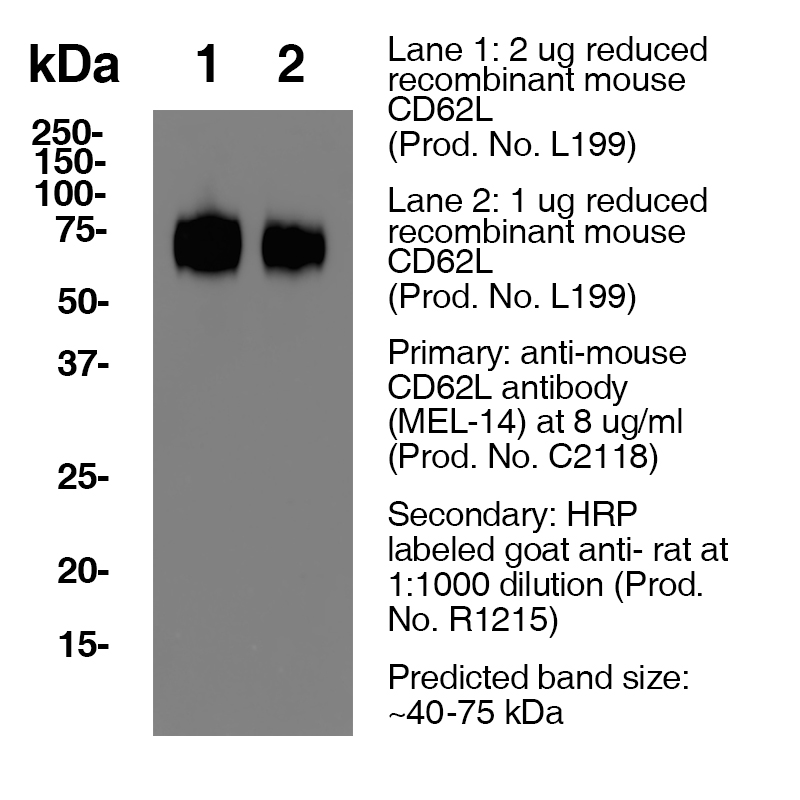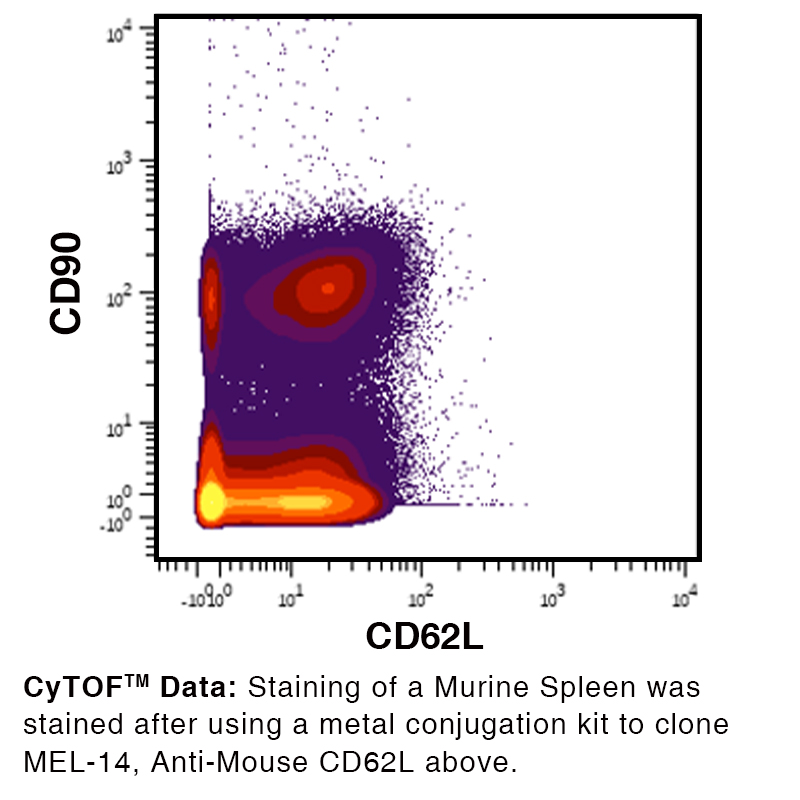Anti-Mouse CD62L [Clone MEL-14] — Purified in vivo GOLD™ Functional Grade
Anti-Mouse CD62L [Clone MEL-14] — Purified in vivo GOLD™ Functional Grade
Product No.: C2118
Clone MEL-14 Target CD62L Formats AvailableView All Product Type Monoclonal Antibody Alternate Names L-selectin, LECAM-1, Ly-22, LAM-1, MEL-14 Isotype Rat IgG2a κ Applications B , CyTOF® , Depletion , FA , FC , IHC FF , in vivo , IP , WB |
Data
Antibody DetailsProduct DetailsReactive Species Mouse Host Species Rat Recommended Isotype Controls Recommended Isotype Controls Recommended Dilution Buffer Immunogen C3H/eb mouse B lymphoma 38C-13 Product Concentration ≥ 5.0 mg/ml Endotoxin Level < 1.0 EU/mg as determined by the LAL method Purity ≥95% monomer by analytical SEC ⋅ >95% by SDS Page Formulation This monoclonal antibody is aseptically packaged and formulated in 0.01 M phosphate buffered saline (150 mM NaCl) PBS pH 7.2 - 7.4 with no carrier protein, potassium, calcium or preservatives added. Due to inherent biochemical properties of antibodies, certain products may be prone to precipitation over time. Precipitation may be removed by aseptic centrifugation and/or filtration. Product Preparation Functional grade preclinical antibodies are manufactured in an animal free facility using in vitro cell culture techniques and are purified by a multi-step process including the use of protein A or G to assure extremely low levels of endotoxins, leachable protein A or aggregates. Storage and Handling Functional grade preclinical antibodies may be stored sterile as received at 2-8°C for up to one month. For longer term storage, aseptically aliquot in working volumes without diluting and store at ≤ -70°C. Avoid Repeated Freeze Thaw Cycles. Country of Origin USA Shipping Next Day 2-8°C RRIDAB_2737457 Applications and Recommended Usage? Quality Tested by Leinco FC The suggested concentration for this MEL-14 antibody for staining cells in flow cytometry is ≤ 0.25 μg per 106 cells in a volume of 100 μl. Titration of the reagent is recommended for optimal performance for each application.
WB The suggested concentration for this MEL-14 antibody for use in western blotting is 1-10 μg/ml. Additional Applications Reported In Literature ? CyTOF® Additional Reported Applications For Relevant Conjugates ? IHC (Paraffin) For specific conjugates of this clone, review literature for suggested application details. Each investigator should determine their own optimal working dilution for specific applications. See directions on lot specific datasheets, as information may periodically change. DescriptionDescriptionSpecificity Rat Anti-Mouse CD62L (Clone MEL-14) recognizes an epitope on Mouse CD62L. This monoclonal antibody was purified using multi-step affinity chromatography methods such as Protein A or G depending on the species and isotype. Background CD62L is a 74-95 kD glycoprotein is a member of the selectin family and is expressed on the majority of B and naïve T cells, a subset of memory T cells, monocytes, granulocytes, most thymocytes, and a subset of NK cells. Furthermore, CD62L is a cell adhesion molecule that binds to many glycoprotein ligands including CD34, GlyCAM-1, and PSGL-1. Clone MEL-14 is reported as a Nutralization antibody. Antigen Distribution Subsets of B and T cells, monocytes, granulocytes, subset of NK cells Ligand/Receptor CD34, GlyCAM-1, MAdCAM-1 Function Lymphocyte homing to HEV, rolling on activated endothelium PubMed NCBI Gene Bank ID UniProt.org Research Area Cell Adhesion . Cell Biology . Costimulatory Molecules . Immunology . Innate Immunity Leinco Antibody AdvisorPowered by AI: AI is experimental and still learning how to provide the best assistance. It may occasionally generate incorrect or incomplete responses. Please do not rely solely on its recommendations when making purchasing decisions or designing experiments. Clone MEL-14, a rat monoclonal antibody targeting mouse CD62L (L-selectin), has two primary in vivo applications in mouse research models. Functional Blockade of Lymphocyte HomingThe most prominent in vivo application of MEL-14 is blocking lymphocyte trafficking to lymph nodes. Pre-incubation of lymphocytes with MEL-14 completely and specifically blocks the binding of lymphocytes to high endothelial venules (HEV) in vitro and prevents the migration of lymphocytes to lymph nodes in vivo. This functional blocking capability makes MEL-14 valuable for investigating lymphocyte extravasation and homing mechanisms. The antibody inhibits in vivo lymphocyte extravasation into peripheral lymph nodes by interfering with CD62L's role as a "homing receptor" for lymphocytes entering secondary lymphoid tissues via high endothelial venules. Flow Cytometric Identification of Lymphocyte SubpopulationsMEL-14 serves as a surface marker for identifying and characterizing lymphocyte subsets in vivo studies. Since CD62L is expressed on the majority of naïve T and B cells, a subset of memory T cells, monocytes, neutrophils, granulocytes, NK cells, and most thymocytes, MEL-14 allows researchers to distinguish between different lymphocyte populations based on their CD62L expression patterns. This is particularly useful for differentiating naïve from memory T cells, as CD62L expression levels vary between these subsets. The antibody is available in multiple formats specifically designed for in vivo use, including purified functional grade formulations with low endotoxin content to ensure compatibility with live animal studies. Commonly used antibodies or proteins that are frequently reported in the literature alongside MEL-14 (anti-mouse CD62L/L-selectin) include markers for T and B cell subsets, activation markers, adhesion molecules, and trafficking markers. Key antibodies and proteins often used with MEL-14 are:
These combinations are critical in studies focused on lymphocyte characterization, trafficking, homing, and activation status. For example, using MEL-14 with antibodies against CD44 and CCR7 permits discrimination between naïve, central memory, and effector memory T cell subsets by flow cytometry or immunofluorescence. In addition, experiments may combine MEL-14 with markers to identify functional changes following activation or trafficking inhibition. MEL-14 is also routinely used in panels for flow cytometry with surface markers and other adhesion molecules to evaluate lymphocyte migration and immune status. The MEL-14 monoclonal antibody is a significant tool in immunological research, notably for its specificity to the murine homing receptor, which is later identified as CD62L (L-Selectin). Key findings from scientific literature citing clone MEL-14 include:
Dosing regimens for clone MEL-14, a monoclonal antibody against mouse CD62L (L-selectin), can vary depending on the specific application and mouse model used in research. Here are some general considerations and guidelines: General Considerations
Specific Mouse Models
Variability in Dosing Regimens
For precise dosing information in specific mouse models, researchers typically consult the literature or perform pilot studies to determine the optimal dose and administration schedule. References & Citations1.) Gubin, M. et al. (2018) Cell. 175(4):1014–1030.e19 Journal Link Technical ProtocolsCertificate of Analysis |
Related Products
Prod No. | Description |
|---|---|
S211 | |
R1364 | |
I-1177 | |
C247 | |
F1175 | |
R1214 | |
S571 |
Formats Available
Prod No. | Description |
|---|---|
C2103 | |
C2091 | |
C2092 | |
C2094 | |
C2089 | |
C2095 | |
C2096 | |
C2097 | |
C2099 | |
C2100 | |
C2101 | |
C2093 | |
C2118 | |
C6118 |
 Products are for research use only. Not for use in diagnostic or therapeutic procedures.
Products are for research use only. Not for use in diagnostic or therapeutic procedures.




